Kerala Plus Two Business Studies Chapter Wise Questions and Answers Chapter 11 Marketing Management
Plus Two Business Studies Marketing Management One Mark Questions and Answers
Question 1.
It begins even before production of goods and continues even after the sale has taken place. Identify it.
Answer:
Marketing
Question 2.
Modern Marketing Concept Consist of ………………………………
Answer:
Customer satisfaction
Question 3.
Main focus of production concept of marketing is: …………………………
Answer:
Quantity/number of products
Question 4.
means putting identification marks on the package.
Answer:
Labelling
Question 5.
“Mousy cola” a soft drink company used ‘Apple’ as their symbol for advertisement. They duly registered the symbol as per the Act. Identify the symbol as …………….
Answer:
Trademark
Question 6.
When a brand gets registerd and legalized it is called
(a) Branding
(b) Trademark
(c) Copyright
(d) Label
Answer:
(b) Trademark
Question 7.
Setting up of standards or specification of a product and maintaining these standards are ………….
Answer:
Standardisation
Question 8.
“Grand Kerala shopping festival” is concerned with which of the promotion techniques?
(a) Publicity
(b) Advertising
(c) Sales promotion
(d) Personal selling
Answer:
(c) Sales promotion
Question 9.
During Gnam season Khadi Board declared 20% reduction on all its product. This technique is known as ……..
(a) Refund
(b) Free gift
(c) Rebate
(d) Samples
Answer:
(c) Rebate
Question 10.
Which of the following is not included in the sales promotion technique.
(a) Coupon
(b) Samples
(c) Fair and exhibition
(d) Personal selling
Answer:
(d) Personal selling
Question 11.
Face to face interaction between the seller and the prospective buyer for the purpose of making a sale is …………
(a) Promotion
(b) Public Relations
(c) Personal Selling
(d) Grape – Vine Communication
Answer:
(c) Personal Selling
Question 12.
Identify four P’s in marketing mix.
Answer:
- Product
- Price
- Place and
- Promotion
Question 13.
Complete the diagram.
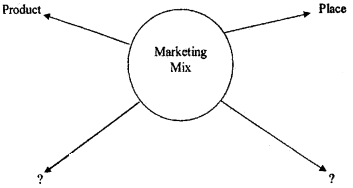
Answer:
Price, Promotion
Question 14.
Nonpersonal paid form of sales promotion technique is ………………
(Advertising, Personal Selling, Trade, Marketing)
Answer:
Advertisement
Question 15.
Nonpersonal non paid form of sales promotion technique is …………
Answer:
Publicity
Question 16.
which is not a method of publicity?
(a) News
(b) Medias
(c) Conferences
(d) Exhibitions
Answer:
(d) Exhibitions
Question 17.
Rebate, discount, free gift, etc. are the examples of …………..
Answer:
Sales promotion techniques
Question 18.
Offering more quantity than the quantity recorded in package is called …………
Answer:
Quantity gift
Question 19.
Match the following.
| A | B |
| a) Rebate | a) Pay back the cash, if the customer is not satisfied with the product |
| b) Money refund | b) Sell the goods at a lesser price than the retail price |
| c) Discount | c) Give small quantity of product at free |
| d) Sample | d) Discounted price on retail price of a product |
Answer:
| A | B |
| a) Rebate | b) Sell the goods at a lesser price than the retail price |
| b) Money refund | a) Pay back the cash, if the customer is not satisfied with the product |
| c) Discount | d) Discounted price on retail price of a product |
| d) Sample | c) Give small quantity of product at free |
Question 20.
What is meant by ‘place’ in marketing mix?
Answer:
Distribution channel, Physical distribution
Question 21.
Fill in the blanks.

Answer:
Publicity, Sales promotion
Question 22.
Compensation provided by the buyer to the seller is called ………………….
Answer:
Price
Question 23.
Intermediaries in channel of distribution are given below. Draw appropriate channel.
(a) Producer
(b) Agent
(c) Wholesaler
(d) Retailer
(e) Consume
- Zero level channel
- One level channel
- Two level channel
- Three level channel
Answer:
- a → e
- a → d → e
- a → c → d → e
- a → b → c → d → e
Question 24.
Complete the diagram.
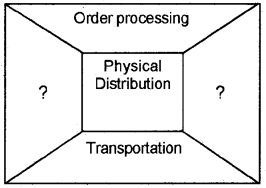
Answer:
Warehousing, Inventory control
Question 25.
What are the different layers of packages?

Answer:
- Primary package
- Secondary package
- Transportation package
Question 26.
Which is not suitable for good brand name?
(a) It is easy to read and speak.
(b) Similar to existing brand names.
(c) Can be written in various languages.
(d) It can be registered as trademark.
Answer:
(b) Similar to existing brand names
Question 27.
Fill in the blanks.
(a) Trademark – Registered brand
(b) Brand name – ……………….
(c) Brand mark – ……………….
Answer:
(b) Indicate the product name
(c) Symbol or word or combination of both which indicate a product.
Question 28.
Make suitable pairs from the following.
(a) Production concept – (a) Quality products
(b) Product concept – (b) Sales promotion techniques
(c) Sales concept – (c) Customer satisfaction
(d) Marketing concept – (d) Maximum production
Answer:
(a) Production concept – (d) Maximum production
(b) Product concept – (a) Quality products
(c) Sales concept – (b) Sales promotion techniques
(d) Marketing concept – (c) Customer satisfaction
Question 29.
Differentiate the given concepts in an appropriate way.
| Marketing | Selling |
| a) Wide concept | a) Let the seller beware |
| b) Satisfaction of seller | b) Product is important |
| c) Customer is important | c) Narrow concept |
| d) Let the buyer beware | d) Satisfaction of customers |
Answer:
| Marketing | Selling |
| a) Wide concept | a) Satisfaction of seller |
| b) Customer is important | b) Let the buyer beware |
| c) Let the seller beware | c) Product is important |
| d) Satisfaction of customers | d) Narrow concept |
Question 30.
Buying a product by spending a lot of time and effort is called ………………..
Answer:
Speciality products
Plus Two Business Studies Marketing Management Two Mark Questions and Answers
Question 31.
Explain the concept of ‘Market’.
Answer:
Market: It refers to a place where the buyers and sellers meet each other for sale and purchase of the commodity.
Question 32.
Define Marketing.
Answer:
Marketing:
Marketing may be defined as all activities that are facilitating the movement of goods and services from producer to the ultimate consumer.
Question 33.
What do you mean by Marketing Mix?
Answer:
Marketing Mix:
It refers to the combination of four basic marketing tools (Product, Price, Place and Promotion) that a firm uses to pursue its marketing objectives in a target market.

Question 34.
Super Bakers intended to introduce a new brand of Bread in the market. Lists out the factors to be taken into account while deciding the labelling of the product.
Answer:
Labelling means putting identification marks on the package. It is a simple tag attached to the product.
Functions of Labelling:
- It describes the product, its usage, cautions in use, etc. and specify its contents.
- It helps in identifying the product.
- It helps grading the products into different categories.
- It helps in promotion of products.
- It provides information required by law.
Question 35.
Distinguish between advertisement and publicity.
Answer:
| Advertisement | Publicity |
| 1) It is a paid form of communication | 1) It is a non-paid form of communication |
| 2) There is an identified sponsor | 2) There is no identified sponsor |
Question 36.
Write a short note on
- Consumer goods
- Industrial goods
Answer:
1. Consumers’ products:
Products, which are purchased by the ultimate consumers for satisfying their personal needs and wants are referred to as consumer products. Consumer products are classified as:
- Shopping efforts involved
- Durability of products
2. Industrial Products:
Industrial products are those products, which are used as inputs in producing other products. The examples of such products are raw materials, engines, lubricants, machines, tools, etc.
Types of industrial products:
- Materials and Parts – These include goods that enter the manufacture’s products completely.
- Capital Items – These goods are used in the production of finished goods.
- Supplies and Business Services – These are short lasting goods and services that facilitate developing or managing the finished product.
Plus Two Business Studies Marketing Management Three Mark Questions and Answers
Question 37.
Customer is the King in the Modern concept of marketing. Explain.
Answer:
According to modem marketing concept, the producer gives more importance to the tastes and needs of the consumer. The objective of modem marketing is maximum profit through consumer satisfaction. Now a days, producers produce products according to the needs of the customers. Consumer is the key to marketing and hence consumer is the king.
Question 38.
- What do you mean by Product Mix?
- Explain its elements.
Answer:
1. Product:
Product may be defined as anything that can be offered to a market to satisfy a want or need. Products may broadly be classified into two categories.
2. Elements:
- Consumers products
- Industrial products
Question 39.
Why Packaging is called as a silent salesman?
Answer:
Packaging is called as a silent salesman because attractive packing encourages people to buy a product just like a salesman.
Question 40.
Explain promotion mix.
Answer:
Promotion Mix:
Promotion mix refers to combination of promotional tools such as Advertising, Personal Selling, Sales Promotion, and Publicity used by an organisation to achieve its communication objectives.
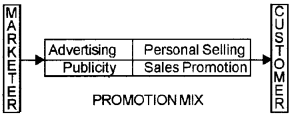
Question 41.
- What do you mean by Public Relation?
- State any three features of public relations.
Answer:
1. Public Relation:
It can be defined as publicity through media. The basic purpose of public relation is to create successful relation with the public. It helps to keep different public group satisfied. In order to create public image, the public relation department uses various tools such as.
2. Features of public relations:
- News
- Speeches
- Events
- Written materials
- Public service activities, etc.
Question 42.
‘‘Marketing Mix represents a blending of decisions in four interrelated elements.” Explain.
Answer:
Marketing Mix:
It refers to the combination of four basic marketing tools (Product, Price, Place and Promotion) that a firm uses to pursue its marketing objectives in a target market.
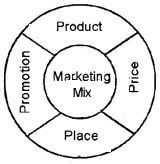
Plus Two Business Studies Marketing Management Four Mark Questions and Answers
Question 43.
In a classroom debate ‘Smitha’ argues that marketing and selling are same. But ‘Sujith’ argues that marketing and selling are different.
- Whose argument is relevant?
- Justify your answer.
Answer:
1. Sujith’s argument is correct.
2. Marketing and selling are different. The differences between marketing and selling are
| Marketing | Selling |
| Marketing is a wider term consisting of number of activities. | It is a narrow concept. |
| It is concerned with product planning and development. | It is concerned with sale of goods already produced. |
| It focuses on maximum satisfaction of the customer. | It focuses on the maximum satisfaction of the sellers through the exchange of products. |
| It aims at profits through consumer satisfaction. | It aims at maximum profit through maximisation of sales. |
| Marketing begins before actual production. | Selling takes place after the production. |
| It is customer oriented. Customer is important. | It is product oriented. Product is more important. |
| The principle of “let the seller beware” is followed, | The principle of “let the buyer” beware is followed. |
Question 44.
There are four elements which constitute the core of a marketing system.
- Suggest a suitable term to describe those elements.
- Explain any three elements.
Answer:
1. Marketing mix
2. Marketing Mix: It refers to the combination of four basic marketing tools (Product, Price, Place and Promotion) that a firm uses to pursue its marketing objectives in a target market.
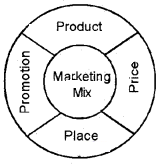
Elements / 4 P’s of Marketing Mix:
1. Product:
Product means goods or services or ‘anything of value’, which is offered to the market for sale. The important product decisions include deciding about the features, quality, packaging, labelling and branding of the products.
2. Price:
Price is the amount of money paid by the customers to pay to obtain the product. In most of the products, price affects the demand of the products. Desired profits, cost of production, competition, demands, etc. must be considered before fixing the price of a product.
3. Place:
Place or Physical Distribution includes activities that make firm’s products available to the target customers. Important decision areas in this respect include selection of dealers, storage, warehousing and transportation of goods from the place of production to the place of consumption.
4. Promotion:
Promotion includes activities that communicate availability, features, merits, etc. of the products to the target customers and persuade them to buy it. It includes advertising, personal selling, sales promotion and publicity to promote the sale of products.
Question 45.
“It rightly says that packaging works as silent salesman”.
- Do you agree?
- Explain.
Answer:
1. Yes.
2. Packaging is the process of enclosing a product in containers, bottles, boxes, plastic bags, tubes, etc. Packaging protects the product from spoilage, breakage, leakage, etc. while goods in transit or storing in warehouses.
Functions of packaging:
- Packaging helps in identification of the products.
- Packaging protects the product from spoilage, breakage, leakage, etc.
- It facilitates easy transfer of goods to customers.
- Packaging provides convenience in the storage of the product.
- It attracts the consumers to purchase the product.
Question 46.
These are various channel levels which help in the proper distribution of goods from the producers to the consumers. Identify the channel levels.
Answer:
Types of Channels:
- Direct channel (Zero level): Producer → Consumer
- One level channel: Producer → Retailer → Consumer
- Two level channel: Producer → Wholesaler → Retailer → Consumer
- Three level channel: Producer → Agent → Wholesaler → Retailer → Consumer
Question 47.
- What do you mean by Physical distribution?
- Explain its components.
Answer:
1. Physical Distribution:
Physical distribution covers all the activities required to physically move goods from manufacturers to the customers.
2. Components of Physical Distribution:
- Order Processing
- Transportation
- Warehousing
- Inventory Control
Question 48.
What are the features of Salesmanship?
Answer:
Personal Selling:
Personal selling involves face to face contact between the seller and prospective customer with an intension of selling some products. It is a personal form of communication.
Features of Personal Selling:
- It is a direct presentation of the product to the consumers.
- Develop personal relationships with the prospective customers.
- The sales presentation can be adjusted according to the specific needs of the individual customers.
- It is possible to take a direct feedback from the customer.
Plus Two Business Studies Marketing Management Five Mark Questions and Answers
Question 49.
Explain different concepts of marketing.
Answer:
Marketing Concepts:
1. The Production Concept:
This concept believed that profits could be maximised by producing at large scale, thereby reducing the cost of production. Here greater emphasis was given on improving the production and distribution.
2. The Product Concept:
According to this concept quality of the product is more important than quantity. Product improvement became the key to profit maximisation of a firm, under the concept of product orientation.
3. The Selling Concept:
This concept focuses on the sale of products through aggressive selling and promotional techniques to persuade the buyers to buy the products.
4. The Marketing Concept:
Marketing concept implies that focus on the satisfaction of customer’s needs is the key to the success of any organisation in the market. Customer’s satisfaction becomes the focal point of all decision making in the organisation.
5. The Societal Marketing Concept:
This concept stresses not only the customer satisfaction but also gives importance to the welfare of the society.
Question 50.
Following are the statements pertaining to functions performed in marketing. Identify the function of marketing from each statement.
- Physical movement of goods from one place to another.
- Holding goods from the time of production till the time of their sale.
- Collection and analysis of relevant facts to solve marketing problems.
- This includes advertising, personal selling, sales promotion and publicity.
- Separating products into different classes on the basis of certain predetermined standards.
Answer:
- Transportation
- Warehousing
- Marketing research
- Sales Promotion
- Grading
Question 51.
Give any 6 advantages of branding
Answer:
Advantages of branding:
1. Advantages to the Firm
- Branding helps a firm in distinguishing its product from that of its competitors.
- It helps in advertising and display Programmes.
- Branding enables a firm to charge competitive price for its products than that charged by its competitors.
- It helps in Introduction of new product in the market.
2. Advantages to Customers
- Branding helps the customers in identifying the products.
- Branding ensures a particular level of quality of the product.
- Some brands become status symbols because of their quality. It creates a feeling of proud and satisfaction in the consumers.
Question 52.
Explain the difference between Personal selling and Advertising.
Answer:
Difference between Personal Selling and Advertising
| Advertising | Personal Selling |
| It is an impersonal form of communication. | It is a personal form of communication. |
| It is inflexible. | It is highly flexible. |
| Same message is sent to all the customers in a market segment. | The sales talk is adjusted according to the customer’s background and needs. |
| Advertising lacks direct feedback. | Personal selling provides direct and immediate feedback. |
| The cost per person is very low. | The cost per person is very high |
Question 53.
List down the difference between Marketing and Selling.
Answer:
| Marketing | Selling |
| Marketing is a wider term consisting of number of activities. | It is a narrow concept. |
| It is concerned with product planning and development. | It is concerned with sale of goods already produced. |
| It focuses on maximum satisfaction of the customer. | It focuses on the maximum satisfaction of the sellers through the exchange of products. |
| It aims at profits through consumer satisfaction. | It aims at maximum profit through maximisation of sales. |
| Marketing begins before actual production. | Selling takes place after the production. |
| It is customer oriented. Customer is important. | It is product oriented. Product is more important. |
| The principle of “let the seller beware” is followed, | The principle of “let the buyer” beware is followed. |
Question 54.
What are the factors affecting price of a product?
Answer:
Factors Affecting Price Determination:
1. Product Cost:
One of the most important factors affecting price of a product or service is its cost of production and distribution. Fixed Costs, Variable Costs and Semi- Variable Costs are to be considered for determining the price.
2. Demand:
The price of a product is affected by the elasticity of demand of the product. If the demand of a product is inelastic, the firm is in a better position to fix higher prices.
3. Competition:
Competitors’ prices and their anticipated reactions must be considered before fixing the price of a product. In case of high competition, it is desirable to keep price low.
4. Government and Legal Regulations:
In order to protect the interest of public against unfair practices, prices of some essential products are regulated by the government under the Essential Commodities Act., e.g. Medicines.
5. Pricing Objectives:
Another important factor affecting the fixation of price of a product is pricing objectives, e.g. maximisation of profit, market share, etc.
Question 55.
What are the limitations of advertising?
Answer:
Disadvantages / Objections to Advertising:
- Advertisement encourages consumers to buy unwanted goods.
- Most of the advertisements are misleading.
- Advertisement may lead to monopoly of a brand.
- Advertisement is a costly affair. So, ultimately it increases the price of the product.
- Advertisement persuades people to purchase even the interior products.
- It undermines social and ethical values.
Question 56.
“Marketing Mix means a firm’s total marketing programme”.
- Discuss the components that you would consider while finalizing marketing mix of an organisation.
- Explain its importance.
Answer:
1. Marketing Mix:
It refers to the combination of four basic marketing tools (Product, Price, Place and Promotion) that a firm uses to pursue its marketing objectives in a target market.

2. Elements / 4 P’s of Marketing Mix:
1. Product:
Product means goods or services or ‘anything of value’, which is offered to the market for sale. The important product decisions include deciding about the features, quality, packaging, labelling and branding of the products.
2. Price:
Price is the amount of money paid by the customers to pay to obtain the product. In most of the products, price affects the demand of the products. Desired profits, cost of production, competition, demands, etc. must be considered before fixing the price of a product.
3. Place:
Place or Physical Distribution includes activities that make firm’s products available to the target customers. Important decision areas in this respect include selection of dealers, storage, warehousing and transportation of goods from the place of production to the place of consumption.
4. Promotion:
Promotion includes activities that communicate availability, features, merits, etc. of the products to the target customers and persuade them to buy it. It includes advertising, personal selling, sales promotion and publicity to promote the sale of products.
Question 57.
Jyoythi Ltd., a manufacturer of leather bag, has decided to undertake production of leather shoes. As a sample, they produced one model of ladies shoe. Suppose you are the marketing manager of the company and are entrusted with the task of fixing the. price for the shoes. What are the factors to be considered by you while fixing the price of this new pair of shoes.
Answer:
Factors Affecting Price Determination:
1. Product Cost:
One of the most important factors affecting price of a product or service is its cost of production and distribution. Fixed Costs, Variable Costs and Semi- Variable Costs are to be considered for determining the price.
2. Demand:
The price of a product is affected by the elasticity of demand of the product. If the demand of a product is inelastic, the firm is in a better position to fix higher prices.
3. Competition:
Competitors’ prices and their anticipated reactions must be considered before fixing the price of a product. In case of high competition, it is desirable to keep price low.
4. Government and Legal Regulations:
In order to protect the interest of public against unfair practices, prices of some essential products are regulated by the government under the Essential Commodities Act., e.g. Medicines.
5. Pricing Objectives:
Another important factor affecting the fixation of price of a product is pricing objectives, e.g. maximisation of profit, market share, etc.
Plus Two Business Studies Marketing Management Eight Mark Questions and Answers
Question 58.
“The present day marketing is customer oriented . rather than product oriented”. Explain the statement bringing out clearly the nature and objectives of marketing management.
Answer:
Marketing:
Marketing may be defined as all activities that are facilitating the movement of goods and services from producer to the ultimate consumer.
Functions of Marketing:
1. Marketing Research:
Marketing Research is a process of collecting and analysing market information to identify the needs and wants of the customers.
2. Marketing Planning:
Another function of marketing is to develop appropriate marketing plans so that the marketing objectives of the organisation can be achieved.
3. Product Designing and Development:
The products are designed and developed according to the needs and wants of the consumers. It requires decision making on various aspects such as the product to be manufactured, its packing, selling price, quality of the product, etc.
4. Standardisation and Grading:
Standardisation refers to producing goods of predetermined specifications. Grading is the process of classification of products into different groups, on the basis of quality, size, etc.
5. Packaging and Labelling:
Packaging refers to designing and developing the package for the products. Packaging gives protection to goods. Also it attracts the consumers to buy the product. Labelling refers to designing and developing the label to be put on the package.
6. Branding:
A brand is a name, term, sign, symbol, design or some combination of them, used to identify the products of one seller and to differentiate them from those of the competitors.
7. Customer Support Services:
An important function of the marketing management is to develop customer support services such as after sales services, handling customer complaints, etc. which provides maximum satisfaction to the customers.
8. Pricing:
Price of a product refers to the amount of money which customers have to pay to obtain a product. Price is an important factor affecting the success or failure of a product in the market. Price is fixed after taking into account the cost of production, desired profit, competitor’s price, govt, policy, etc.
9. Promotion:
Promotion of products and services involves informing the customers about the firm’s product, its features, etc. and persuading them to purchase these products. It includes Advertising, Personal Selling, Publicity and Sales Promotion.
10. Physical Distribution:
It includes decision regarding channels of distribution and physical movement of the product from the production centre to the consumption centre.
11. Transportation:
Transportation involves physical movement of goods from one place to another. It removes the hindrance of place and creates time utility.
12. Storage or Warehousing:
In order to maintain smooth flow of products in the market, there is a need for proper storage of the products. It stabilizes the prices of products and keep the product without damage until they are sold.
Question 59.
The manager of Impact Enterprises dealing in cosmetics is facing the problem, of poor sales. Suggest and explain the important promotional measures that he can undertake to improve the sales.
Answer:
Techniques of Sales Promotion:
- Rebate: Offering products at special prices, to clear off excess inventory.
- Discount: Offering products at less than maximum retail price.
- Refund: The seller offers to refund a part of the price paid by the customer on production of some proof of purchase.
- Free gifts: Offering another product as gift along with the purchase of a product.
- Quantity Gift: Offering extra quantity of the product.
- Contests: Prize contests are organized for the consumers and winners are given attractive prizes.
- Money refund: There are certain manufacturers who promise to refund the price of the product, if it does not satisfy the consumer.
- Samples: Offer of free samples of a product to customers at the time of introduction of a new product.
Question 60.
“Money spent on advertising is wasteful”.
- Do you agree?
- Give reasons for your answer.
Answer:
Merits of Advertising:
1. Advantages to Manufacturers and Traders:
- Advertising helps in introducing new products.
- It stimulates the consumers to purchase the new products.
- Advertisement helps to increase the sales of new and existing products.
- It helps to increase the goodwill of the firm.
- It helps to face the competition in the market.
- It increases profit of the firm through large sales.
2. Advantages to Consumers:
- It helps the consumers to know about the various products and their prices.
- Consumers can purchase the better products easily.
- It helps in maintaining high standard of living.
- It educates the consumers about the various uses of products.
3. Advantages to the Society:
- Advertisement helps to create more employment opportunities.
- It provides an important source of income to the press, radio, T.V., etc.
- It is a source of encouragement to artists.
- It plays an important role in economic development of the country.
- It reduces number of middlemen and consumers get quality products at lower cost.
Disadvantages / Objections to Advertising:
- Advertisement encourages consumers to buy unwanted goods.
- Most of the advertisements are misleading.
- Advertisement may lead to mono poly of a brand.
- Advertisement is a costly affair. So, ultimately it increases the price of the product.
- Advertisement persuades people to purchase even the interior products.
- It undermines social and ethical values.
